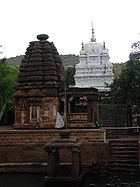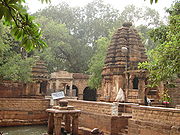
Mahakuta group of temples
Encyclopedia

Bagalkot district
Bāgalkot district is an administrative district in the Indian state of Karnataka. The district headquarters is located in the town of Bagalkot. The district is located in northern Karnataka and borders Belgaum, Gadag, Koppal, Raichur and Bijapur...
of Karnataka
Karnataka
Karnataka , the land of the Kannadigas, is a state in South West India. It was created on 1 November 1956, with the passing of the States Reorganisation Act and this day is annually celebrated as Karnataka Rajyotsava...
state, India. It is an important place of worship for Hindus
Hinduism
Hinduism is the predominant and indigenous religious tradition of the Indian Subcontinent. Hinduism is known to its followers as , amongst many other expressions...
and the location of a well-known Shaiva monastery. The temples are dated to the 6th or 7th century and were constructed by the early kings of the Chalukya dynasty
Chalukya dynasty
The Chalukya dynasty was an Indian royal dynasty that ruled large parts of southern and central India between the 6th and the 12th centuries. During this period, they ruled as three related yet individual dynasties. The earliest dynasty, known as the "Badami Chalukyas", ruled from Vatapi from the...
of Badami
Badami
Badami , formerly known as Vatapi, is a town and headquarters of a taluk by the same name, in the Bagalkot district of Karnataka, India. It was the regal capital of the Badami Chalukyas from 540 to 757 AD. It is famous for rock cut and other structural temples...
. The dating of the temples is based on the style of architecture which is similar to that of the temples in nearby Aihole
Aihole
Aihole is a temple complex in the Bagalkot district of Karnataka, India. It is a very popular tourist spot in north Karnataka. It lies to the east of Pattadakal, along the Malaprabha River, while Badami is to the west of both....
and the discovery of two notable inscriptions in the complex: the Mahakuta Pillar
Mahakuta Pillar
Mahakuta Pillar in the town of Mahakuta in present day Bagalkot district of India's Karnataka state is the source of an important Badami Chalukya inscription called Mahakuta pillar inscription ascribed to king Mangalesa, second son of Pulakesi I. It is made of fine grained sandstone...
inscription dated between 595–602 CE (written in the Sanskrit language and Kannada script
Kannada script
The Kannada script is an alphasyllabary of the Brahmic family, used primarily to write the Kannada language, one of the Dravidian languages of southern India and also Sanskrit in the past. The Telugu script is derived from Old Kannada, and resembles Kannada script...
); and an inscription of Vinapoti, a concubine of king Vijayaditya
Vijayaditya
Vijayaditya followed his father, Vikramaditya I on to the Chalukya throne. His long reign was marked by general peace and prosperity. Vijayaditya also built a number of temples....
, dated between 696–733 CE and written in the Kannada language
Kannada language
Kannada or , is a language spoken in India predominantly in the state of Karnataka. Kannada, whose native speakers are called Kannadigas and number roughly 50 million, is one of the 30 most spoken languages in the world...
and script.
Basic plan
The Karnataka artisans of the 7th century achieved a certain eclectism in their architecture by building south Indian dravida style temples adjacent to north Indian nagara style temples. Further, their dravida and nagara styles were local, indigenous variants and unrelated to the architectural styles that prevailed in modern Tamil NaduTamil Nadu
Tamil Nadu is one of the 28 states of India. Its capital and largest city is Chennai. Tamil Nadu lies in the southernmost part of the Indian Peninsula and is bordered by the union territory of Pondicherry, and the states of Kerala, Karnataka, and Andhra Pradesh...
to the south and Central India ("Madhyadesha") to the north. They achieved this by combining the basic plan of one style with characteristics of the other. The dravida style temples here have a tiered tower over the shrine which is capped with a dome like structure. The nagara style temples use a curvilinear tower over a shrine which has a square plan, and is capped by a ribbed stone. The development of this hybrid style, achieved by combining the typological features of the two basic architectural styles, is considered a peculiarity of the Karnataka region and defines the beginnings of the Vesara
Vesara
Vesara is a type of Indian architecture primarily used in temples. The two other prominent styles are Dravida and Nagara. Vesara is a combination of these two temple styles.-Description:...
style of architecture.

Lotus (plant)
Lotus identifies various plant taxa:* Nelumbo, a genus of aquatic plants with showy flowers** Nelumbo nucifera, the Sacred or Indian lotus** Nelumbo lutea, the American or Yellow lotus...
pool of god Vishnu") and an ablution tank called Papavinasha Tirtha ("Tank of Ablution"). Among the several shrines in the complex, the Mahakutesvara temple, built in the dravida style, and the Mallikarjuna temple are the largest. There is a small shrine in the centre of the Vishnu Pushkarni tank and in it is a Shiva
Shiva
Shiva is a major Hindu deity, and is the destroyer god or transformer among the Trimurti, the Hindu Trinity of the primary aspects of the divine. God Shiva is a yogi who has notice of everything that happens in the world and is the main aspect of life. Yet one with great power lives a life of a...
linga (universal symbol of god Shiva) called Panchamukha linga ("five faced linga"), one face for each direction and one on top.
MAHAKUTA-BAGALKOTE DISTRICT
Best season:
Accommodation:
How to get there:
By Air:
By Rail:
By Road: 14 km from Badami.
Inscriptions
The Mahakuta complex has provided historians with two important 7th century inscriptions. The Mahakuta PillarMahakuta Pillar
Mahakuta Pillar in the town of Mahakuta in present day Bagalkot district of India's Karnataka state is the source of an important Badami Chalukya inscription called Mahakuta pillar inscription ascribed to king Mangalesa, second son of Pulakesi I. It is made of fine grained sandstone...
inscription, dated variously between 595–602 CE records a grant made by Durlabhadevi, a queen of Pulakesi I, the father of king Mangalesa
Mangalesa
Mangalesa succeeded Kirtivarman I to the Chalukya throne. He ruled as regent as the heir to the throne Pulakesi II was considered too young to rule.-Capable warrior:An energetic and ambitious ruler, Mangalesa won several laurels in war...
. The queen supplemented an earlier grant with an endowment of ten villages, including Pattadakal
Pattadakal
Pattadakal is a village in Karnataka. It lies on the banks of the Malaprabha River in Bagalkot district. It is 22 km from Badami and about 10 km from Aihole...
and Aihole to god Mahkutesvara Natha. In addition, the inscription provides important information about the Chalukyan lineage, their military expeditions, their conquests and early monuments. The pillar goes by the name Dharma-jayastambha ("Pillar of victory of religion") and is on exhibition at a Bijapur
Adil Shahi
The Adil Shahi or Adilshahi dynasty ruled the Sultanate of Bijapur in the Western area of the Deccan region of Southern India from 1490 to 1686. Bijapur had been a province of the Bahmani Sultanate , before its political decline in the last quarter of the 15th century and eventual break-up in 1518...
archaeological museum. The other inscription, ascribed to Vinapoti, king Vijayaditya's concubine, is inscribed in the porch of the Mahakutesvara temple. It describes a grant of rubies
Ruby
A ruby is a pink to blood-red colored gemstone, a variety of the mineral corundum . The red color is caused mainly by the presence of the element chromium. Its name comes from ruber, Latin for red. Other varieties of gem-quality corundum are called sapphires...
and a silver umbrella to the deity Mahakutesvara in addition to a piece of land.

